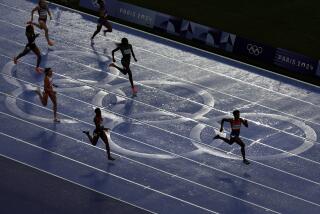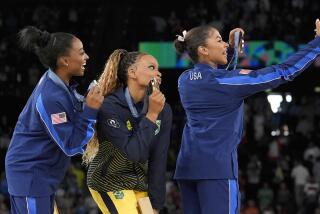Op-Ed: Caster Semenya has a competitive advantage. That’s OK

- Share via
The Court of Arbitration for Sport on Wednesday turned down an appeal from South African track star Caster Semenya. The decision upholds a new rule that to compete in women’s races, runners must have “normal range” levels of testosterone — in other words, lower than Semenya’s. This only confirms suspicions that, rather than protecting fair competition, the new rule unfairly targets Semenya.
The International Assn. of Athletics Federations, the governing body for track and field competition, has had Semenya in its sights since she won the 800 meters at the 2009 world championships. Initially, the IAFF’s focus was on whether she’d used banned performance-enhancing drugs. When those tests turned up negative, the IAAF subjected Semenya to “gender verification” to determine her eligibility to compete as a woman. Through a decade of investigations, delays and rule changes, Semenya has mostly been allowed to compete, and won Olympic gold in 2012 and 2016.
The new IAAF requirement addresses the wrong question. We know that testosterone enhances athletic performance. Instead, the real question is how we should recognize male and female athletes, even those who do not fit the strict binary divisions of gender.
No one has ever suggested that we require male athletes with higher-than-normal androgens to reduce their testosterone to within the ‘normal range’ in men.
Concerns about female athletes who appeared too masculine date back to the 1930s. American sprinter Helen Stephens, for instance, after winning gold in the women’s 100 meters at the 1936 Olympic Games in Berlin was subjected to an impromptu genital examination by Olympic officials, who judged her to be female. Ironically, the accusations against Stephens were brought by Stella Walsh, herself a somewhat masculinized runner for Poland dubbed “Stella the Fella” in the press.
The purported goal of gender verification was to prevent males from posing as females in competition. There has been no recorded instance of normal men passing themselves off as women. And yet sports federations continue to target women who do not conform to feminine norms.
Competition photos of Semenya show a woman with a relatively masculine body type. Though she doesn’t discuss it, news outlets have reported that Semenya has a disorder of sex development that causes naturally high testosterone levels, at least compared with other women.
For several years, the IAAF has been waffling on whether testosterone enhances the performance of elite female athletes. There’s not much good data out there, and testosterone levels change dynamically throughout the day, so a single blood test isn’t an accurate proxy for long-term androgen exposure.
However, after much study, the IAAF concluded in 2011 that testosterone does enhance athletic performance.
This is old news.
A little Endocrinology 101. Testosterone is a steroid hormone that occurs naturally in both men and women. It’s also an androgen, which means it has both masculine characteristic-producing (androgenic) and muscle-building (anabolic) properties. Its muscle-building effects boost athletic performance. That’s why, alongside other anabolic steroids, supplemental testosterone has been banned from Olympic competition since 1976. In the U.S., the Anabolic Steroid Control Act of 1990 classified drugs that are chemically related to testosterone as Schedule III substances and made possession and distribution of them for nonmedical purposes a felony.
If hyperandrogenism gives Semenya an advantage in her particular events, so what? At a height of 7½ feet, Yao Ming has an advantage in basketball; Michael Phelps’ long arms give him an advantage in swimming. All world-class athletes have physical and mental characteristics that make them succeed. In competitions that test the very limits of human abilities, even very small advantages can make the difference.
A photo of the finish line at the 2012 Olympic 800-meter race offers an illustration. Although Semenya was awarded the gold medal in this event, she was not the first runner across the line. It’s Russian Mariya Savinova who was smiling as she finishes a step ahead. However, the athletics court later nullified all of Savinova’s race results from 2010 to 2013 because she’d been using the anabolic steroid oxandrolone.
The medal was stripped from the athlete using exogenous androgens, and was awarded to the athlete with high levels of natural androgens. This is appropriate. Savinova broke the rules; Semenya didn’t.
Enter the Fray: First takes on the news of the minute from L.A. Times Opinion »
Still, the IAAF now has decided that Semenya must take drugs that will artificially lower her testosterone levels to make a “level playing field” for female athletes. And yet no one has ever suggested that we require male athletes with higher-than-normal androgens to reduce their testosterone to accord with the “normal range” in men. Nor do we allow male or female competitors with lower-than-normal testosterone (the so-called “low T”) to artificially boost their levels.
Semenya is a woman. She has identified and always presented herself as a woman. She should be allowed to compete as a woman, unencumbered by medical treatments to limit her natural physiology.
Through all the controversy, Semenya has responded with class and with restraint. In response to this latest decision from the Court of Arbitration for Sport, she tweeted a shrugging emoji with the statement, “Sometimes it’s better to react with no reaction.”
If only the IAAF had done the same.
Ruth Wood is chair of the Department of Integrative Anatomical Sciences at the Keck School of Medicine of USC. She studies the effects of anabolic steroids on brain and behavior.
Follow the Opinion section on Twitter @latimesopinion and Facebook
More to Read
A cure for the common opinion
Get thought-provoking perspectives with our weekly newsletter.
You may occasionally receive promotional content from the Los Angeles Times.









